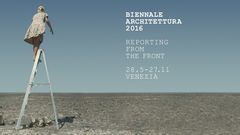Die 15. Internationale Architekturausstellung der Biennale Venedig findet vom 28. Mai bis zum 27. November 2016 unter dem Titel «Reporting from the Front» statt. Die künstlerische Leitung obliegt dem chilenischen Architekten Alejandro Aravena.
83. Studio (Arsenale, Raum 8)
Venice Lightscapes | Local identity – exploring a forgotten resource
Prof. Thomas Auer, Lehrstuhl für Gebäudetechnologie und klimagerechtes Bauen
Transsolar, Matthias Schuler and Anja Thierfelder Freie Architektin
Visible rays of sunlight are called crepuscular rays, or more poetically, angels’ stairs. The installation “lightscapes” by Transsolar and Anja Thierfelder at the XV Venice Biennale reproduces this special phenomenon of atmospheric optics and perspective, which we can all observe against the backdrop of a forest or the sky.
Crepuscular rays can be seen if direct sun light is blocked by obstructions, such as clouds or leaves, and flickers through holes or gaps. To see these rays it is necessary that their light is scattered by micro-particles in the atmosphere, like dust or haze, and that the visual field has high brightness contrast, which is created by bright light rays and dark shadows from the obstructions side by side. Despite seeming to converge at a point, the rays are in fact near-parallel shafts of sunlight. Their apparent convergence is due perspective. When they hit the ground, the light rays create a pattern of light spots, a lightscape on the landscape, so to speak… The new Louvre Abu Dhabi is a prime example of how the local identity of a site can shape architecture. Only the Abu Dhabi-specific high dust levels allow the design vision of the architect Jean Nouvel to be realized: His creation is a visible “rain of light” below the perforated dome above the museum plaza.
Architect: Anja Thierfelder KlimaEngineering: Transsolar Photos: Crepuscular rays in nature (Angel’s stairs, by James Brown) versus installation test in the Arsenal (Transsolar)
76. Studio (zentrale internationale Ausstellung)
MUD WORKS! Ideas and concepts around the structure and installation
Anna Heringer, Gastprofessorin am Lehrstuhl für Architekturgeschichte und kuratorische Praxis, Prof. Andres Lepik mit Martin Rauch, Lehm Ton Erde Baukunst
Earth is more than a building material. The relation between human beings and this material is as old as human kind, but we almost lost contact. This installation invites to experience this material in a very intimate way. In our work we mostly find it difficult to convince clients to believe in the quality of earth, it`s stability, it`s haptic treasures, its richness in colors, the positive influence on our body and mind. This is difficult to transmit via pictures. It needs to be felt. This is why we transformed our exhibition space with 25 tons of mud into an immediate experience built in earth
- a rammed earth floor with a rammed earth bench
- a rammed earth wall piece as an artwork ( Stampflehmbild)
- mud-casein colours on the walls
- a sculpture to sit in called “Pepita” (the Italian word for Nugget) in Zabur technique, layer by layer shaped with the hands only.
Where can one find mud in Venice? The town is made of bricks. The factory and clay source of SanMarco - Terreal Italia is close by, located on the mainland, and has a storied history in producing Venice’s most important building material. This time the mud is unfired!
28. Studio (zentrale internationale Ausstellung)
EPEA Internationale Umweltforschung (Hamburg, Germany)
Prof. Dr. Michael Braungart, Gastprofessor am Institute for Advanced Study
Buchpräsentation
Germania, Venezia im Deutschen Pavillon auf der Architekturbiennale Venedig 2016
Seit 1980 findet in Venedig die Architekturbiennale statt. Nach dem Vorbild der Kunstbiennale sind seit 1991 auch Länderpavillons Bestandteil der Ausstellung – auch jener Deutschlands. Da-mit markiert das seit 1989 mauerlose und seit 1990 wiedervereinigte Deutschland von Anfang an den politisch-kulturellen Referenzrahmen der deutschen Beiträge zur Architekturbiennale Venedig.
Das von Stephan Trüby und Verena Hartbaum herausgegebene Buch Germania, Venezia. Die deutschen Beiträge zur Architekturbiennale Venedig seit 1991 präsentiert zum ersten Mal die bis heute realisierten deutschen Beiträge zur Architekturbiennale Venedig in ihren inhaltlichen, kuratorischen und szenografischen Dimensionen. Eine Oral History mit Interviews aller wichtigen Akteure rekapituliert, wie sich das wiedervereinigte Deutschland auf dieser weltweit wichtigsten Architekturausstellung präsentiert hat.
Stephan Trüby, Verena Hartbaum (Hrsg.): Germania, Venezia. Die deutschen Beiträge zur Architekturbiennale Venedig seit 1991: Eine Oral History
1. Aufl. 2016, ISBN: 978-3-7705-6061-5
Deutscher Pavillon, Giardini, Venedig
28. Mai 2016, 13–14:30 Uhr
Grußwort von Staatssekretär Gunther Adler, anschließend Diskussion mit Oliver Elser, Francesca Ferguson, Burkhard Grashorn, Verena Hartbaum, Peter Cachola Schmal und Stephan Trüby.
Moderation: Florian Heilmeyer.
15. Internationale Architekturausstellung La Biennale di Venezia
28. Mai - 27. November 2016
